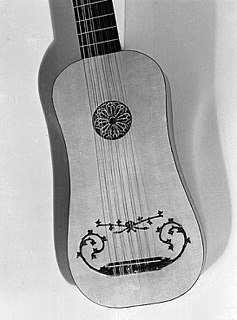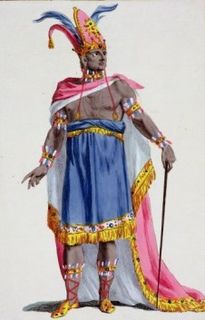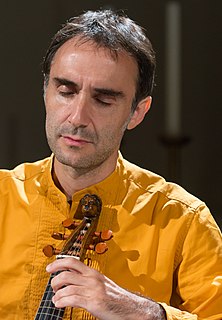
The viol, viola da gamba, or informally gamba, is any one of a family of bowed, fretted and stringed instruments with hollow wooden bodies and pegboxes where the tension on the strings can be increased or decreased to adjust the pitch of each of the strings. Frets on the viol are usually made of gut, tied on the fingerboard around the instrument's neck, to enable the performer to stop the strings more cleanly. Frets improve consistency of intonation and lend the stopped notes a tone that better matches the open strings. Viols first appeared in Spain in the mid to late 15th century and were most popular in the Renaissance and Baroque (1600–1750) periods. Early ancestors include the Arabic rebab and the medieval European vielle, but later, more direct possible ancestors include the Venetian viole and the 15th- and 16th-century Spanish vihuela, a 6-course plucked instrument tuned like a lute that looked like but was quite distinct from the 4-course guitar.

The vihuela is a 15th-century fretted plucked Spanish string instrument, shaped like a guitar but tuned like a lute. It was used in 15th- and 16th-century Spain as the equivalent of the lute in Italy and has a large resultant repertory. There were usually five or six doubled strings.

Federico Maria Sardelli is an Italian conductor, historicist, composer, musicologist, and flautist. He founded the medieval ensemble Modo Antiquo in 1984. In 1987, Modo Antiquo also became a baroque orchestra, debuting with the performance of Jean-Baptiste Lully's Ballet des Saisons in front of an audience of about five thousand.

Motezuma, RV 723, is an opera in three acts by Antonio Vivaldi with an Italian libretto by Alvise Giusti. The libretto is very loosely based on the life of the Aztec ruler Montezuma who died in 1520. The first performance was given in the Teatro Sant'Angelo in Venice on 14 November 1733. The music was thought to have been lost, but was discovered in 2002 in the archive of the music library of the Sing-Akademie zu Berlin. Its first fully staged performance in modern times took place in Düsseldorf, Germany, on 21 September 2005.
Hille Perl is a German virtuoso performer of the viola da gamba and lirone. She is considered to be one of the world's finest viola da gamba players, specializing in solo and ensemble music of the 17th and 18th centuries. She has a particular interest in French Baroque repertoire for seven-string bass viola da gamba. She also performs Spanish, Italian, German, and modern repertoire for the instrument and has released many CDs.
The Harp Consort is an international early music ensemble directed by Andrew Lawrence-King, specialising in Baroque opera, early dance-music, and historical World Music.

Vittorio Ghielmi is an Italian musician, conductor, composer. Compared by critics to Jasha Heifetz (“Diapason”) for his virtuosity, and described as “An Alchemist of sound” for the intensity and versatility of his musical interpretations, Vittorio Ghielmi attracted notice while still very young for his new approach to the viola da gamba and to the sound of early music repertoire. He is Professor for viola da gamba and Head of the Institut für Alte Musik at the Mozarteum Universität Salzburg and Visiting Professor at the Royal College of London. He is graduate at the Università Cattolica di Milano.
La Favoritte is an early music ensemble, founded in 2002, that has specialized in the performance of Baroque music on period instruments. The ensemble also enjoys stretching the bounds of its repertoire to include Medieval, Renaissance and contemporary works. The special focus of La Favoritte is the music of women composers, and the musical traditions of early Canada; great artists from ages past, including Élisabeth Jacquet de La Guerre and Barbara Strozzi, as well as the Augustine and Ursuline Nuns of New France. Since its inception as a trio, La Favoritte has grown to a larger ensemble frequently performing as a full-sized Baroque orchestra including winds, brass, and timpani. La Favoritte is a supporter of Ottawa's new chamber music concert hall in partnership with The Ottawa Chamber Music Society (www.chamberfest.com) through the Online Auction for the Arts.
Oni Wytars is an early music ensemble that was founded in 1983 by Marco Ambrosini and Peter Rabanser.
Pro Anima was a musical ensemble from Leningrad, founded in 1977. They were specialized in medieval music. Its founder and leader was former jazz musician Gennady Golstain. They have participated in early music festivals and released some recordings on Melodiya label (USSR). The ensemble has been disbanded in 1990s.

Tieteberga (RV737) is a partially lost dramma per musica by Antonio Vivaldi. The Italian libretto was by Antonio Maria Lucchini.

Archiv Produktion is a classical music record label of German origin. It originated in 1949 as a classical label for the Deutsche Grammophon Gesellschaft (DGG), and in 1958 Archiv was established as a subsidiary of DGG, specialising in recordings of Early and Baroque music. It has since developed a particular focus on "historically informed performance" and the work of artists of the Early music revival movement of the 20th and 21st centuries.

Didier François is a Belgian musician specialized in nyckelharpa and a sculptor living in Mechelen in Belgium.
Cappella Artemisia is an Italian all-female vocal group specializing in the music of the convents of 17th-century Italy. The group was founded by the American, but resident in Italy, singer and musicologist Candace Smith. Smith is also co-publisher, with her husband cornettist Bruce Dickey of editions of this music through Artemisia Editions. The main repertoire of the group focuses on nun composers themselves - including Raphaella Aleotti, the first nun to publish as a composer, Maria Xaveria Perucona and Isabella Leonarda, Chiara Margarita Cozzolani and Rosa Giacinta Badalla, Sulpitia Cesis, Alba Tressina, Lucrezia Orsina Vizzana and Caterina Assandra. The ensemble also performs works of the male composers - some monks, some secular, who dedicated works to the covents.

Modo Antiquo is an Italian instrumental ensemble dedicated to the performance of Baroque, Renaissance, and Medieval music. It was founded in 1984 by Federico Maria Sardelli. Twice nominated for a Grammy award, the ensemble has an extensive discography, primarily on the Naïve, Brilliant Classics, and Tactus labels and have given the first performances in modern times of several works by Vivaldi. Modo Antiquo's larger ensemble is its Baroque orchestra led by Sardelli. It also has a smaller ensemble devoted to Medieval and Renaissance music led by Bettina Hoffmann.
Romina Basso is an Italian mezzo-soprano with an extensive discography of baroque opera recordings. She is particularly noted for her performances of Vivaldi.
Martha Elizabeth Blackman is an American viola da gamba player and lutenist, and the first American to perform on and teach the viol.
Lorenza Borrani is an Italian violinist. She performs as leader, director, soloist and chamber musician, all over the world.
Judith Davidoff is an American viol player, cellist, and performer on the medieval bowed instruments. Her recorded performances reflect her wide range of repertoire and styles, including such works as Schoenberg's Verklaerte Nacht and 13th-century monody. She is responsible for the catalog of 20th- and 21st-century viol music.









